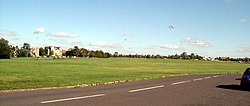Clifton Down
| Clifton Down | |
|---|---|
 Clifton Down | |
| Type | public open space |
| Location | Bristol, England |
| Coordinates | 51°28′10″N 2°37′08″W / 51.46945°N 2.619°W |
| Area | 400 acres (160 ha) |
| Open | All year |

Clifton Down is an area of public open space in


History
There is an Iron Age
In the Middle Ages Clifton Down was the
By the mid-19th century Clifton Down ceased to be used for grazing. Clifton became a desirable place to live, and large houses were built close to Clifton Down. Bristol Corporation became concerned at the threat to this public amenity, and in 1861 promoted an Act of Parliament, under which the Society of Merchant Venturers undertook to secure Clifton Down for public enjoyment free of charge.[2]
Since 1861 Clifton Down has been managed, with Durdham Down, by the Downs Committee, a joint committee of the Society of Merchant Venturers and Bristol City Council, which owns Durdham Down.[3] The committee appoints a Downs Ranger to oversee the Downs.[4]
Suffragette meeting
On 20 September 1908 there was a meeting across the road near the water tower to support the Suffragette movement: some 10,000 people were there.[5]
World War II
Stone cairns were placed on all open spaces to deter landings of enemy aircraft: the cairns were removed in 1944. In May 1941, 32 acres were requisitioned on the east side of Ladies Mile to store military vehicles in six canvas hangars. There was a tank repair area near the Sea Walls. An area of 42 acres to the west of Ladies Mile was used from February 1944 to store heavy army equipment.[5]
Features
The downs, Clifton and Durdham, are separated by the busy commuter road of Stoke Road, passing the prominent 'concrete elephant' water tower and adjoining tea room. At right angles to Stoke Road runs the dead straight 'Ladies Mile', to the South West corner of the Downs and Bridge Valley Road. In Victorian and Edwardian times this was a promenading and horse-riding spot for the affluent, similar to Rotten Row in London. After the Great War, it remained a promenading spot, but now on a more commercial basis.[6]
From the southwest corner of Clifton Down, in an area known as the Sea Wall, there are panoramic views of the Avon Gorge and the Clifton Suspension Bridge.
Near Clifton village is the site of the
A railway
Part of Clifton Down was used by
See also
- Victoria Hughes, lavatory attendant at Stoke Road and autobiographer.[6]
References
- ISSN 0309-7994. Retrieved 5 November 2022.
- ^ The Downs Committee, The Downs: Clifton and Durdham Downs, 1861-1961 (Bristol, 1961)
- ^ Cameron, Amanda (24 January 2022). "Merchant Venturers asked to give Clifton Down to city of Bristol". Bristol Post. Retrieved 31 January 2023.
- ^ "History of The Downs".
- ^ a b Friends of the Downs and Avon Gorge "Welcome Issue" pamphlet 2016.
- ^ ISBN 0902920316.
- ^ Batten, Rhiannon (28 March 2014). "Top 10 outdoor activities in Bristol". The Guardian. Retrieved 7 May 2018.
- ^ "Concern over scrub clearance work". BBC News. 8 July 2008. Retrieved 7 May 2018.

